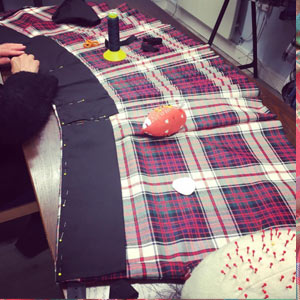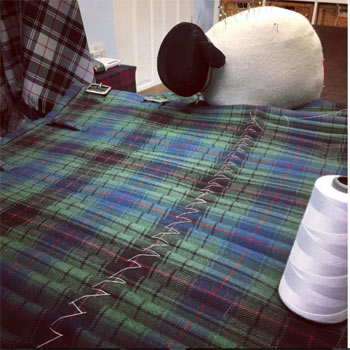Why a Hand Stitched Kilt is better than Machine Sewn
To explain the difference. Only with a hand stitched kilt can you achieve proper shaping – the common feedback we get is how surprised people are about how well their kilt fits.

You can see the shaping in this kilt
For a machine sewn kilt this wouldn’t have the dip it would be straight.
A kilt should be made from 100% Wool Mill.
Being a natural fibre Wool is naturally weather resistant and also fire retardant. It holds the pleats perfectly. A hand stitched kilt made from 100% wool can be re-made and re-made.A kilt made from cheaper materials or a lower quality wool mix you will see 'balloon' out in any kind of moisture. Someone will start the night with their kilt looking ok but by the end it looks like a skirt made from a bad quality rug, the pleats are barely visible.
Invisible Stitching
A hand sewn kilt has invisible stitching on the pleats. With a machine sewn kilt you can see the lines on stitching. Hand sewn kilts use special strengthened thread. Each time a pleat is started the kilt maker knots the thread to make sure nothing comes unstitched a few years down the line.
The pleats are steeked, this means that extra stitching is put in place to stop the pleats falling. With some kilts you can see pleats drooping at the back.
The internal construction of our kilts uses canvas that makes the kilt mould to your shape, this also echoes the shaping of the kilt. Rather than with machine sewn where they just re-use templates for set sizes – a hand stitched kilt is made to your exact measurements. On top of the canvas we add cotton lining.
Adding the lining
A Kilt Makers Knowledge goes into your kilt
Machine sewn kilts are nearly always made to a general size. Templates are created for say a 32 waist 38 seat. If you order a 32 waist, 38 seat this is exactly what you get. People rarely measure themselves correctly and this exact size will most likely have a very tight seat and worn incorrectly because it won't sit well with the body. You will see people where the fell is too short or too long. The pleats should hang from the widest part of the bottom - here the pleats hang straight. If the fell is too high you get a weird stipe across the bottom, too long and the pleats all bunch up.
This is a sign of corners cut and nearly always this comes with a machine sewn kilt.
A Kilt Maker works with all body shapes and understands the differences. A super skinny person will have a slightly looser waist so the kilt sits better on the hips. What to do with a firm belly or soft belly. What to do when you know someone has given you the wrong sizes. This is truly a skill. Most of the Kilts we sell at The Kiltmakery we never get to meet and measure the person so understanding these types of bodies is a must. We know when to pull in the waist a bit. Give someone a higher rise etc etc. We don't need someone physically in front of us to achieve this.
Different Pleats - Working Directly with the Kilt Maker has huge benefits.
If you are buying a machine sewn kilt you get your templated kilt from a sales person who does not make kilts. Working with hand stitched directly with the Kiltmaker (at the Kiltmakery you are speaking with the Kilt Maker) you have access to all the knowledge and expertise from the actual craftsperson.They know the range of ways to pleat up the tartan first hand. You will find out for example you want a Rob Roy Tartan Kilt that we recently made one pleated to the back and it looked stunning. Let us pin it up the various ways so you can see all the choices. You are part of the story of your kilt being made.
Pleating to stripe or to sett

This Kilt is Pleated to Sett
